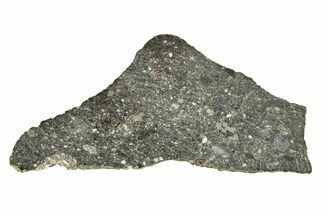This Specimen has been sold.
1.39" Lunar Meteorite Fragment (5.5 g) - NWA 15373
This is a 1.39" wide (5.5 gram) fragment of the lunar meteorite, NWA 15373.
NWA 15373 Meteorite
NWA 15373 is a 45-kilogram fragmented lunar breccia purchased from a Moroccan dealer in 2022. The mass is mainly small fragments; the largest found fragment so far is about 2.6 kilograms. When cut, it resembles most lunar breccias with light and dark gray clasts held in dark gray groundmass, interspersed with light shock veins. It also contains plagioclase, pigeonite, augite, and olivine.
Lunar Meteorite: Northwest Africa 15373
NWA 15373 is a 45-kilogram fragmented lunar breccia purchased from a Moroccan dealer in 2022. The mass is mainly small fragments; the largest found fragment so far is about 2.6 kilograms. When cut, it resembles most lunar breccias with light and dark gray clasts held in dark gray groundmass, interspersed with light shock veins. It also contains plagioclase, pigeonite, augite, and olivine.
Lunar Meteorite: Northwest Africa 15373
Moon Rocks... On Earth...
Think the only moon rocks on Earth are samples brought back from Apollo missions? Think again!
Lunar meteorites are type of achondrite meteorites that were formed like other stony (chondrite) meteorites, but they were ejected into space by meteorites and other celestial bodies hitting the moon. Almost all lunar meteorites are brecciated amalgamations of feldspathic and basaltic rocks commonly found on the Moon's surface.
Lunar meteorites are pretty rare to find on Earth: the vast majority of meteorites are from the asteroid belt, and less than 1 percent of classified meteorites are lunar in origin. The total mass of all known lunar meteorites is probably less than 1,000 kilograms. Owning a piece of the moon is a pretty rare accomplishment!
One reason they are so rare is because lunar meteorites superficially look just like earth rocks. Even a true meteorite expert would not recognize a lunar meteor laying on the ground among earthly stones. Lunar meteorites have only been recognized in places naturally devoid of rocks, like sandy deserts and ice sheets. In fact, there has never been a lunar meteorite classified from North America, South America or Europe. Most are found in the Sahara Desert (Northwest Africa), Antarctica, or Oman. All Antarctic meteorites are governmental property so they cannot be privately attained.
Think the only moon rocks on Earth are samples brought back from Apollo missions? Think again!
Lunar meteorites are type of achondrite meteorites that were formed like other stony (chondrite) meteorites, but they were ejected into space by meteorites and other celestial bodies hitting the moon. Almost all lunar meteorites are brecciated amalgamations of feldspathic and basaltic rocks commonly found on the Moon's surface.
Lunar meteorites are pretty rare to find on Earth: the vast majority of meteorites are from the asteroid belt, and less than 1 percent of classified meteorites are lunar in origin. The total mass of all known lunar meteorites is probably less than 1,000 kilograms. Owning a piece of the moon is a pretty rare accomplishment!
One reason they are so rare is because lunar meteorites superficially look just like earth rocks. Even a true meteorite expert would not recognize a lunar meteor laying on the ground among earthly stones. Lunar meteorites have only been recognized in places naturally devoid of rocks, like sandy deserts and ice sheets. In fact, there has never been a lunar meteorite classified from North America, South America or Europe. Most are found in the Sahara Desert (Northwest Africa), Antarctica, or Oman. All Antarctic meteorites are governmental property so they cannot be privately attained.
TYPE
Lunar (Feldspathic Breccia)
AGE
LOCATION
Northwest Africa
SIZE
Size: 1.39 x .68", .36", Weight: 5.5 grams
CATEGORY
SUB CATEGORY
ITEM
#304062
 Reviews
Reviews












